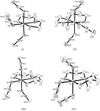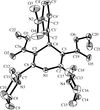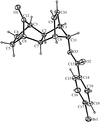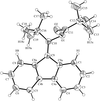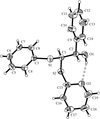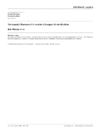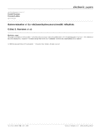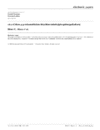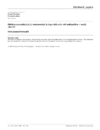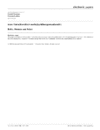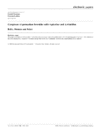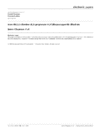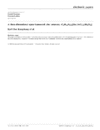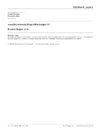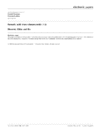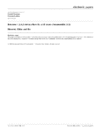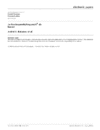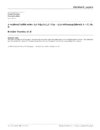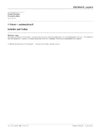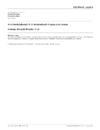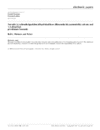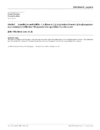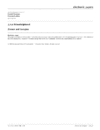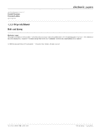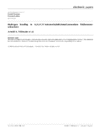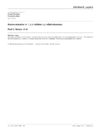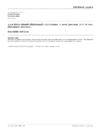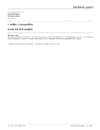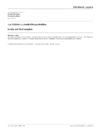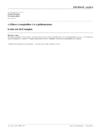issue contents
November 2000 issue

Cover illustration: Packing diagram for the low-temperature phase of tetraphenylphosphonium perchlorate. All Ph4P+ cations are crystallographically identical. Ellipsoids are shown at the 50% probability level. See Batten, Harris & Murray [Acta Cryst. (2000), C56, 1394-1395].
inorganic compounds
Download citation


Download citation


Precise X-ray and neutron structural determinations of Na2Fe(CN)5(NO)·2D2O performed at very low temperatures are presented. The X-ray and neutron diffraction positional and atomic displacement parameters agree very well. The [Fe(CN)5(NO)]2− anion has approximate octahedral stereochemistry.
Download citation


Download citation


BiV0.4FeIII3O(PO4)3 exists as a branched polymeric chain of Fe atoms singly or doubly bridged by oxo and phosphate O atoms, in between which are found Bi sites.
Download citation


Download citation


In the title compound, octahedrally coordinated vanadium and tetrahedral sulfate ions share corners to form layers that are held together by hydrogen bonds and by sodium ions, which are located between the layers.
metal-organic compounds
Download citation


Download citation


Download citation


Download citation


Download citation


Download citation


Download citation


Download citation


Download citation


Download citation


Download citation


Download citation


Download citation


Download citation


Download citation


Download citation


Download citation


Download citation


Download citation


Download citation


Download citation


Download citation


Download citation


Download citation


Download citation


Download citation


Download citation


Download citation


Download citation


Download citation


Download citation


Download citation


organic compounds
Download citation


Download citation


Download citation


Download citation


Download citation


Download citation


Download citation


Download citation


Download citation


Download citation


Download citation


Download citation


Download citation


Download citation


Download citation


Download citation


Download citation


Download citation


Download citation


Download citation


Download citation


Download citation


Download citation


Download citation


Download citation


Download citation


Download citation


Download citation


Download citation


Download citation


Download citation


Download citation


Download citation


Download citation


Download citation


Download citation


Download citation


Download citation


Download citation


Download citation


Download citation


Download citation


Download citation


Download citation


Download citation


Download citation


Download citation


Download citation


Download citation


Download citation


Download citation


Download citation


Download citation


Download citation


Download citation


Download citation


electronic papers (metal-organic compounds)
Download citation


Download citation


The cation of the title compound displays a rhomboidal geometry for the Au atoms, with short Au⋯Au distances of 3.104 (2) and 3.185 (1) Å. The anion shows the expected square-planar geometry at AuIII, with the Au atom 0.022 (5) Å out of the plane of the four donor atoms.
Download citation


Download citation


In the title complex, the Cu atom, which is located on an inversion centre, is in the centre of a distorted octahedral geometry, with six O atoms provided by two monodentate carboxylate groups and four water molecules. Intra- and intermolecular hydrogen bonds make up a three-dimensional network.
Download citation


Download citation


The previously reported title compound (R = 0.12, one of water molecules disordered) has been redetermined (R = 0.041, no disorder). The complex has pseudo-octahedral geometry around the FeIII atom. There is extensive hydrogen bonding involving the water molecules and the hydroxamate ligands.
Download citation


Download citation


The title compound, prepared in the course of synthetic studies of organochalcogenide compounds of PdII, has bridging chloro and arylthiolato groups, with the phosphines being trans to the bridging chloro group. The four-membered metallocyclic Pd2ClS ring is unexpectedly non-planar, with a dihedral angle of 133.8 (1)° between the PdCl2SP coordination planes.
Download citation


Download citation


The preparation and crystal structure of the title complex are described. The ZnII ion adopts a distorted tetrahedral coordination. It is bonded to two thiocyanate and two pyridyl N atoms.
Download citation


Download citation


The structure of the title compound is the first example of an addition compound of GeCl4 with two aromatic nitrogen bases. The environment around the Ge atom can be described as a slightly distorted octahedron with the 4-methylpyridine ligands occupying axial positions and the four chloro ligands in the equatorial plane. The structure of the title compound is isomorphous with the corresponding silicon halides.
Download citation


Download citation


The reactions of GeBr4 with 4-methylpyridine and 3,4-dimethylpyridine lead to tetrabromobis(4-methylpyridine)germanium, (I>), and tetrabromobis(3,4-dimethylpyridine)germanium, (II>), respectively. These structures show the same features as the corresponding silicon complexes.
Download citation


Download citation


The title copper complex has a center of symmetry and a distorted octahedral coordination, with four N atoms in equatorial positions and water molecules in the apical sites. The water molecule of crystallization is hydrogen bonded to the deprotonated carboxylate group of the ligand.
Download citation


Download citation


The title compound is a new open-framework zinc arsenate, which is isostructural with the zinc phosphate UiO-17. The open three-dimensional anionic framework, made up of vertex-sharing AsO4 tetrahedra, ZnO4 tetrahedra and ZnO5 trigonal bipyramids, contains a two-dimensional eight-ring channel system in which diprotonated piperazinium cations reside.
Download citation


Download citation


The title compound crystallizes as a monomer, with the copper ion in a pentacoordinated square-pyramidal environment, bisected by a twofold axis passing through the metal atom and the apex. The molecules organise in chains connected by hydrogen bonds running along the unique b axis.
electronic papers (organic compounds)
Download citation


Download citation


In the title adduct, fumaric acid has a centre of symmetry and is connected to two trans-cinnamamide molecules through cyclic hydrogen bonds. A single-crystal photoirradiation promoted the conformational disorder of the fumaric acid.
Download citation


Download citation


In the two title adducts, (I>) and (II>), respectively, the dicarboxylic acid is connected to two cinnamamide molecules through cyclic hydrogen bonds. The arrangement of the C=C bonds of neighbouring cinnamamide molecules is twisted.
Download citation


Download citation


In the title adduct, a hydrogen-bonded unit of the acid and two cinnamamide molecules has a crystallographic twofold axis parallel to b, and the acid molecules are linked by cyclic hydrogen bonds to form a flat zigzag along c.
Download citation


Download citation


In the title compound, the tosyloxymethyl substituent is in an endo position; the BH3 group is equatorial and the (N-bonded) methyl group is axial, relative to the six-membered heterocycle. The N—B bond of 1.649 (8) Å is one of the longest known.
Download citation


Download citation


The three title sterically encumbered terphenyl halides are isomorphous and isostructural with a plane of symmetry through the centre of the molecule. The C—X bond distances are 1.745 (3) [X = Cl, (I)], 1.910 (4) [X = Br, (II)] and 2.102 (6) Å [X = I, (III)].
Download citation


Download citation


The relative molecular stereochemistry and crystal packing of the diterpenoid ternifoline-C at 150 K are similar to the results of a previous study probably using room-temperature data.
Download citation


Download citation


The 5-fluoropyrimidine-2,4(1H,3H)-dione moiety of the title compound is similar to the known structure of 1-acetyl-5-fluorouracil. The 1-octanoyl group and the 5-fluorouracil moiety are essentially coplanar with the acyl carbonyl group, which is oriented towards the ring C—H group and away from the nearer ring carbonyl group.
Download citation


Download citation


In the title compound, the furan ring is inclined at an angle of 84.35 (4)° to the phenyl ring. The crystal structure is dominated by van der Waals forces.
Download citation


Download citation


The crystal structure of the title compound contains a crystallographic inversion center. The C—C bond linking the two halves of the molecule is slightly elongated at 1.577 (3) Å.
Download citation


Download citation


In the course of an attempt to synthesize tetrakis(3,5-dimethylpyridine)dihydridosilicon dibromide, crystals of its acetonitrile disolvate, (I>), and of 3,5-dimethylpyridinium bromide, (II), were obtained in the same reaction flask. They have both been structurally characterized.
Download citation


Download citation


The title compound has peripheral acetyl and carbomethoxy groups which show disorder. The absolute structure, known from the starting materials, was confirmed by the analysis.
Download citation


Download citation


A one-dimensional connectivity of strong hydrogen bonds in this simple structure results in a b axis which is very short compared with a and c. This provides a perfect example for the concept of periodic bond-chain vectors.
Download citation


Download citation


In the title compound, the biuret moiety is nearly planar and an intramolecular hydrogen bond completes a six-membered ring. Each phenyl ring of the p-tolyl groups is twisted by approximately 60–80° with respect to the others.
Download citation


Download citation


The title crystal structure reveals hydrogen bonding between the benzeneselenolate anions and the tetramethylethylenediammonium cations.
Download citation


Download citation


The crystal structure at 153 K of the title compound, an intermediate in the synthesis of 1,3,5-trichloro-2,4,6-trinitrobenzene, shows no major deviations from the previously reported structure at 295 K other than the expected contraction of the cell volume.
Download citation


Download citation


The title structure consists of separate molecules arranged in sheets parallel to the ab plane. In each molecule, the central (CN)3 ring, the ethynyl units, and the Si atoms lie in the same plane. Typical C—C and C—N bond distances are 1.197 (5) and 1.42 (4) Å, respectively. The angles inside the (CN)3 ring range from 114 (3) to 125 (3)° and the acetylenic branches are nearly linear.
Download citation


Download citation


The structure of the title compound comprises a racemic mixture of chiral molecules associated by N—H⋯N hydrogen-bonding interactions. The dihedral angle between the two rings is 77.90 (6)°.
Download citation


Download citation


The structure of the title compound comprises two unique molecules that separately form hydrogen-bonded polymer chains via N—H⋯N interactions. Molecular independence arises due to a difference in the dihedral angles between the linked rings, i.e. 52.19 (4) and 46.17 (5)°.
Download citation


Download citation


The structure of the title compound comprises six symmetry unique molecules that vary only slightly in their N—C—S—C torsion angle. All the molecules are planar to within less than 3.1°.
Download citation


Download citation


The structure of the title compound comprises essentially planar molecules stacked parallel to the a axis. C—H⋯O hydrogen-bonding interactions exist to both naphthoquinone O atoms and the Cl atom, but not to the morpholine O atom.
addenda and errata
Download citation


Download citation


Free 



 journal menu
journal menu



























